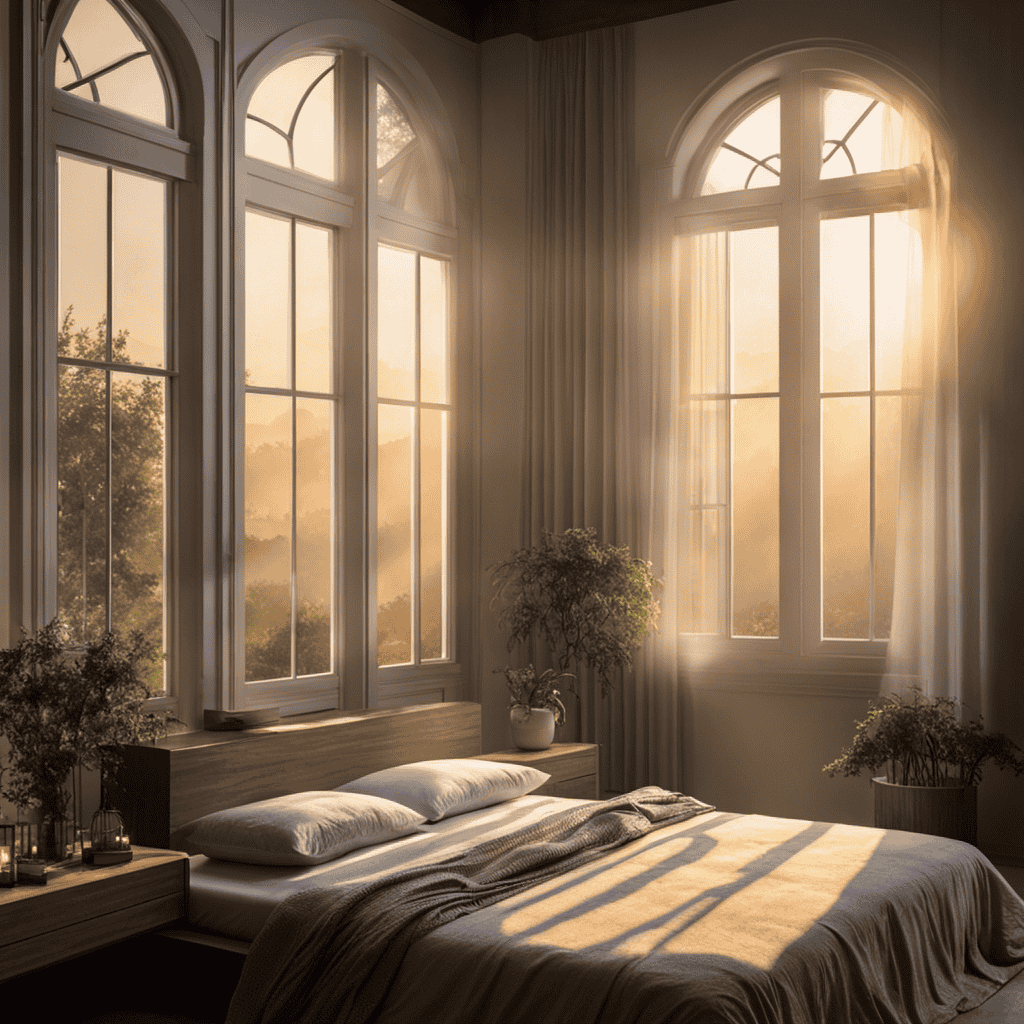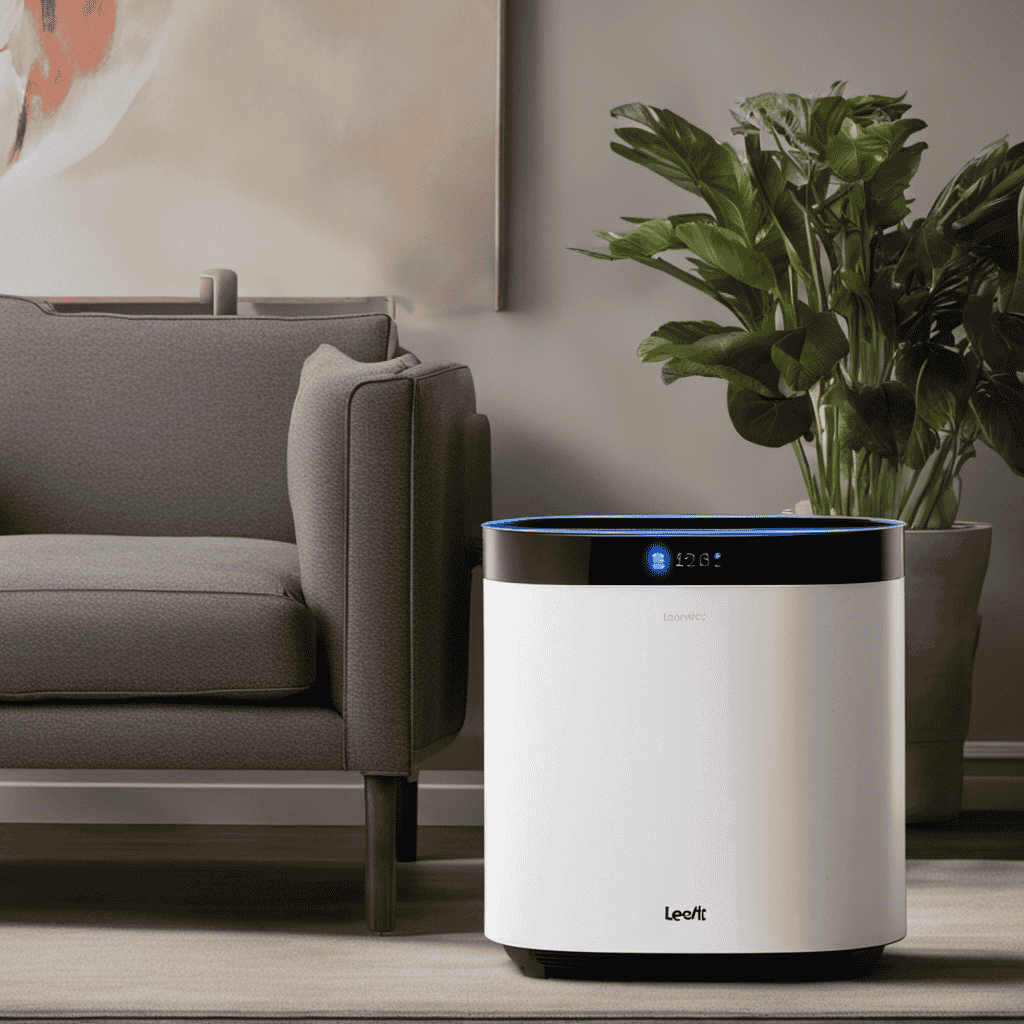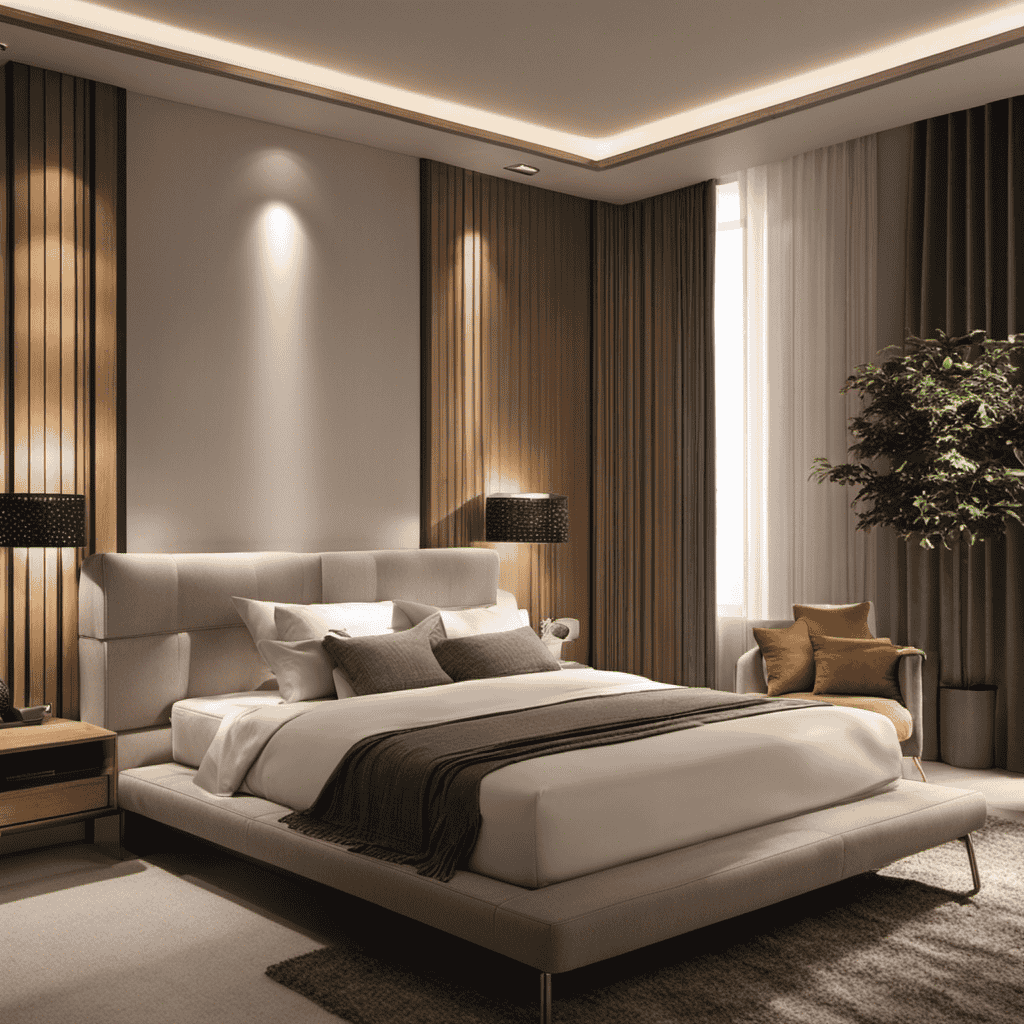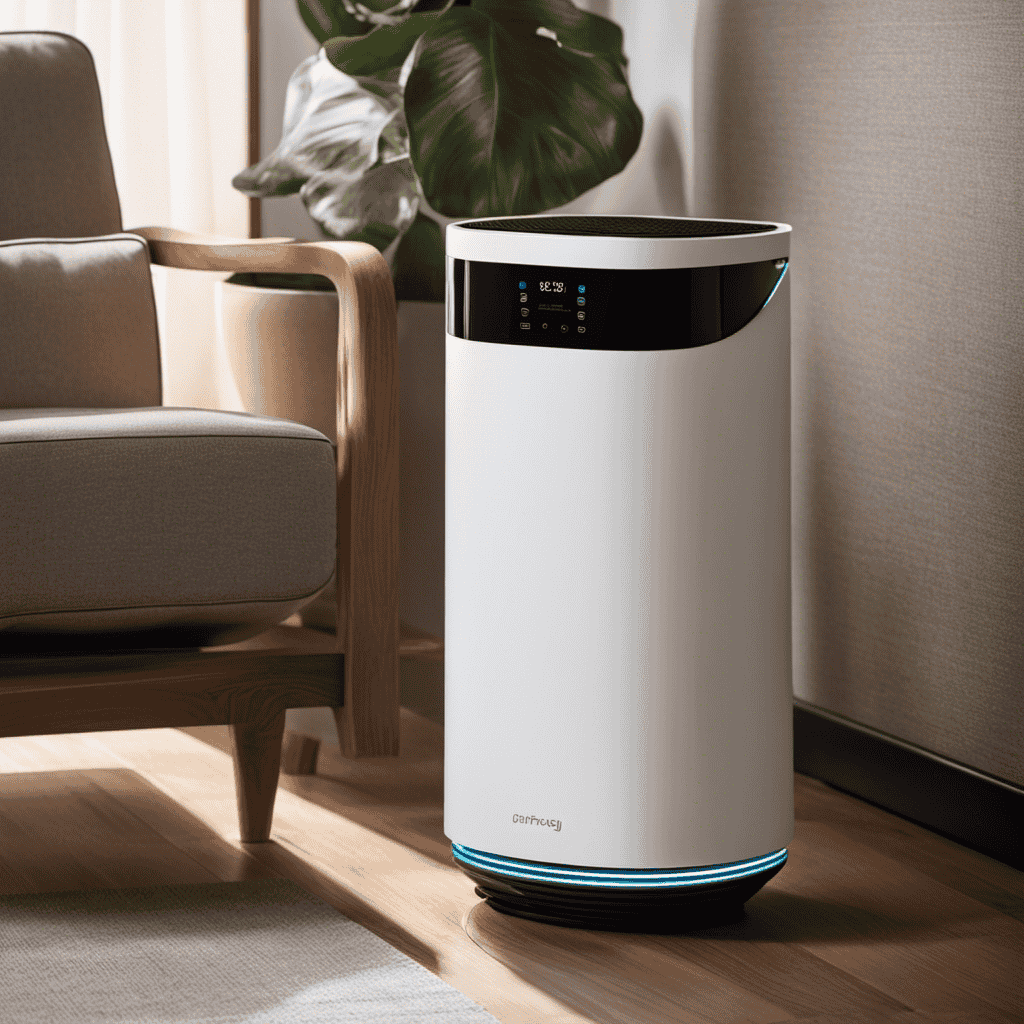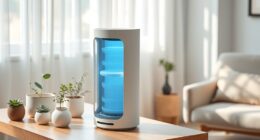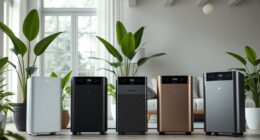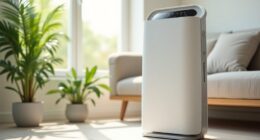Why is an air purifier necessary when I am surrounded by stale, polluted air in my home?
The answer lies in the invisible dangers that lurk within our indoor spaces. Indoor air pollution, filled with allergens, mold spores, and harmful chemicals, can wreak havoc on our health.
But fear not, for an air purifier is the knight in shining armor, ready to cleanse the air of these unseen foes.
Let’s dive deep into the scientific evidence and explore the undeniable benefits of having an air purifier in your home.
Key Takeaways
- Exposure to indoor air pollutants can lead to respiratory conditions like asthma and COPD.
- Air pollution may also affect cognitive function and contribute to neuroinflammation and neurodegenerative diseases.
- Addressing indoor air pollution is crucial for safeguarding respiratory health and cognitive well-being.
- Air purifiers can filter out harmful chemicals and VOCs found in cleaning products, paints, and furniture, providing cleaner indoor air.
The Impact of Indoor Air Pollution
Indoor air pollution can have a significant impact on our health and well-being. Understanding respiratory illnesses is crucial in recognizing the dangers of air pollution.
Studies have shown that exposure to indoor air pollutants can lead to various respiratory conditions, such as asthma and chronic obstructive pulmonary disease (COPD). These pollutants, including particulate matter, volatile organic compounds (VOCs), and biological agents, can irritate the airways and cause inflammation, leading to respiratory symptoms and reduced lung function.
Additionally, emerging research suggests that air pollution may also affect cognitive function. Fine particulate matter, for example, can reach the brain and potentially contribute to neuroinflammation and neurodegenerative diseases.
Therefore, it is essential to address indoor air pollution to safeguard our respiratory health and cognitive well-being. Understanding the impact of airborne allergens further highlights the importance of air purification.
Understanding Airborne Allergens
To better comprehend airborne allergens, it’s essential to understand the types of particles that can trigger allergic reactions and how they can infiltrate your living environment.
-
Pollen: These tiny grains, released by plants and trees, are a common trigger for respiratory conditions like hay fever.
-
Dust mites: These microscopic creatures thrive in warm and humid environments, and their waste particles can cause nasal congestion and sneezing.
-
Pet dander: Shed skin cells from pets contain allergenic proteins that can lead to itchy eyes, coughing, and wheezing in susceptible individuals.
-
Mold spores: Mold grows in damp areas and releases spores into the air, which can cause respiratory symptoms such as coughing, wheezing, and shortness of breath.
Understanding these allergens is crucial in managing indoor allergies and protecting your respiratory health. By identifying potential sources and implementing effective strategies, such as using air purifiers, you can create a healthier living environment.
This is particularly important because poor indoor air quality can have harmful effects on our health and well-being.
Harmful Effects of Poor Indoor Air Quality
Exposure to poor indoor air quality can lead to various health issues, such as respiratory problems and allergies. The importance of ventilation cannot be overstated when it comes to maintaining good indoor air quality. Proper ventilation helps to remove pollutants and improve air circulation, reducing the risk of health problems.
However, in some cases, ventilation alone may not be enough to combat indoor air pollution. This is where air purifiers play a crucial role. Air purifiers are devices designed to remove harmful particles from the air, such as dust, pollen, pet dander, and even some viruses and bacteria. By capturing and trapping these pollutants, air purifiers can significantly reduce the presence of respiratory irritants in the indoor environment, thereby alleviating symptoms and improving overall air quality.
Research has shown that using air purifiers can effectively reduce respiratory symptoms, such as coughing, wheezing, and sneezing, particularly in individuals with allergies or asthma. Therefore, investing in an air purifier can be a practical solution to improve indoor air quality and protect our respiratory health.
Health Benefits of Using an Air Purifier
Using an air purifier can effectively reduce respiratory symptoms, such as coughing and sneezing. Research has shown that air purifiers provide numerous benefits for improving respiratory health:
-
Removes airborne allergens: Air purifiers can filter out common allergens like pollen, dust mites, and pet dander, reducing the triggers for respiratory allergies.
-
Eliminates harmful pollutants: Indoor air can contain pollutants such as volatile organic compounds (VOCs), tobacco smoke, and mold spores. Air purifiers can remove these harmful substances, improving the air quality.
-
Reduces asthma attacks: By removing asthma triggers like dust and pet dander, air purifiers can help reduce the frequency and severity of asthma attacks.
-
Filters out bacteria and viruses: Some air purifiers are equipped with HEPA filters that can capture tiny particles, including bacteria and viruses, reducing the risk of respiratory infections.
Investing in an air purifier can significantly benefit your respiratory health by providing cleaner and healthier indoor air.
Common Sources of Indoor Air Pollution
As I delve into the topic of common sources of indoor air pollution, it is crucial to address three key points: harmful household chemicals, pet dander and fur, and mold and mildew.
These sources are not only prevalent but also pose significant risks to our health. Harmful household chemicals, such as cleaning agents and air fresheners, release volatile organic compounds (VOCs) that can cause respiratory issues and other health problems.
Pet dander and fur, although seemingly harmless, can trigger allergies and asthma attacks in susceptible individuals.
Lastly, the presence of mold and mildew can lead to respiratory issues and exacerbate existing conditions, particularly in those with compromised immune systems.
Understanding these sources is essential for effectively managing indoor air quality and safeguarding our well-being.
Harmful Household Chemicals
To protect yourself from harmful household chemicals, it is essential to consider having an air purifier in your home. Air purifiers are effective tools for removing pesticides and reducing indoor toxins. Here are four reasons why having an air purifier is essential for a healthy home environment:
-
Air purifiers can filter out harmful chemicals, such as volatile organic compounds (VOCs), commonly found in cleaning products, paints, and furniture.
-
They can also capture and remove pesticides present in the air, ensuring that you and your family are not constantly exposed to these toxic substances.
-
Air purifiers with activated carbon filters can effectively trap and neutralize harmful gases and odors, improving the overall air quality in your home.
-
By reducing the levels of indoor toxins, air purifiers can help alleviate symptoms of respiratory conditions, such as asthma and allergies.
Investing in an air purifier can provide you with peace of mind, knowing that you are taking proactive steps to create a safer and healthier living environment for yourself and your loved ones.
Pet Dander and Fur
If you have pets, their dander and fur can contribute to poor indoor air quality. Pet dander, which consists of tiny flakes of skin, can trigger allergic reactions in some individuals. It contains allergens that can cause symptoms like sneezing, itching, and congestion in people with pet allergies.
Additionally, pet hair can also worsen indoor air quality as it can contain dust, pollen, and other allergens that can be inhaled and cause respiratory problems. These allergens can linger in the air and settle on surfaces, making it difficult for people with allergies to find relief even in their own homes.
To minimize the impact of pet dander and fur on indoor air quality, regular grooming, vacuuming, and using an air purifier can be effective strategies. An air purifier with a HEPA filter can help capture and remove pet allergens from the air, providing a cleaner and healthier environment for both pet owners and non-pet owners alike.
Mold and Mildew
Mold and mildew can thrive in damp and humid environments, posing health risks and contributing to poor indoor air quality. To prevent respiratory issues and eliminate musty odors, it is essential to address the presence of mold and mildew.
Here are some key steps to take:
- Maintain proper ventilation to reduce humidity levels.
- Keep indoor spaces dry by using dehumidifiers or air conditioners.
- Regularly clean and dry areas prone to moisture, such as bathrooms and basements.
- Use mold-resistant materials in construction or renovation projects.
By following these preventive measures, you can minimize the growth of mold and mildew, improving indoor air quality and reducing the risk of respiratory issues.
Now, let’s explore how air purifiers work to further enhance the air we breathe.
How Air Purifiers Work
You’ll be amazed at how air purifiers work to remove pollutants and allergens from your home. Air purifiers are equipped with advanced technology that allows them to effectively filter the air and improve indoor air quality. The main mechanism behind air purifiers is the use of filters, which capture and trap particles such as dust, pollen, pet dander, and even bacteria and viruses. These filters are typically made of materials like activated carbon or HEPA (High-Efficiency Particulate Air) filters, which have been proven to be highly effective in removing airborne contaminants.
Air purifiers work by drawing in air from the surrounding environment and passing it through these filters, where the pollutants and allergens are trapped. The clean air is then released back into the room, providing you with fresh and purified air to breathe. Some air purifiers also incorporate additional technologies, such as UV-C light or ionizers, to further enhance their effectiveness in eliminating harmful substances.
To better understand the benefits of air purifiers, let’s take a look at a table that highlights some of the key features and technologies commonly found in air purifiers:
| Feature / Technology | Description |
|---|---|
| HEPA Filters | Highly efficient in capturing small particles, including allergens and pollutants |
| Activated Carbon Filters | Effective in removing odors and volatile organic compounds (VOCs) |
| UV-C Light | Destroys bacteria, viruses, and other microorganisms |
| Ionizers | Release negatively charged ions to neutralize airborne particles |
As you can see, air purifiers offer a range of benefits and utilize various technologies to ensure cleaner and healthier air in your home. These devices have been extensively researched and proven to be effective in reducing the levels of indoor air pollutants, which can have a significant impact on your respiratory health. By investing in an air purifier, you can create a safer and more comfortable living environment for you and your family.
Types of Air Purifiers and Their Features
When considering the different types of air purifiers available on the market, it is important to examine the filter types and efficiency. Different filters, such as HEPA or activated carbon, can effectively capture different types of pollutants and allergens.
Additionally, noise levels and operation are crucial factors to consider, as some air purifiers may emit loud sounds or have complex operation modes.
Filter Types and Efficiency
There are various filter types available for air purifiers, each with different levels of efficiency. When it comes to ensuring clean and healthy air, two popular filter technologies stand out: HEPA filters and activated carbon filters.
HEPA (High-Efficiency Particulate Air) filters are designed to trap microscopic particles as small as 0.3 microns, including allergens, dust, pet dander, and pollen. They are highly effective in removing airborne pollutants and improving indoor air quality.
Activated carbon filters work by adsorbing gases, odors, and chemicals. Their porous structure allows them to trap and neutralize harmful substances, providing an additional layer of purification. They are particularly effective in eliminating smoke, volatile organic compounds (VOCs), and unpleasant odors.
By combining HEPA filter technology and activated carbon filters, air purifiers can effectively remove both solid particles and harmful gases, ensuring the air you breathe is clean and fresh.
Now, let’s explore another important aspect of air purifiers: noise levels and operation.
Noise Levels and Operation
In addition to considering filter types and efficiency, another important factor to consider when choosing an air purifier is the noise levels and operation. No one wants a noisy appliance disrupting their peace and quiet. That’s why many air purifiers are designed to operate silently, ensuring a peaceful environment while still effectively purifying the air.
Noise reduction in air purifiers is achieved through various methods, such as using advanced fan technology, sound-dampening materials, and efficient motor designs. These features work together to minimize noise without compromising the purifier’s effectiveness.
When researching air purifiers, it’s essential to look for models that specifically advertise silent operation or noise reduction features. Reading customer reviews and expert opinions can also provide insights into the noise levels of different air purifier models.
Size and Portability
One important aspect to consider when choosing an air purifier is its size and portability. A compact design and easy portability can offer several benefits for the user.
Here are some key advantages of a portable air purifier:
-
Convenience: A smaller and lightweight air purifier can be easily moved from one room to another, allowing you to purify the air wherever you go.
-
Versatility: The portability of the air purifier allows you to use it in different spaces such as your bedroom, living room, or even your office, ensuring clean and fresh air wherever you spend your time.
-
Travel-friendly: If you frequently travel or have a need for clean air while on the go, a compact air purifier can be a great companion to ensure you breathe clean air wherever you are.
-
Easy maintenance: A smaller air purifier generally requires less maintenance, making it easier to clean and replace filters when needed.
Considering the benefits of portability and compact design, it is essential to choose the right air purifier that suits your specific needs and preferences.
Choosing the Right Air Purifier for Your Needs
When choosing the right air purifier for your needs, it’s important to consider the size of the room you will be using it in. A larger room will require a more powerful air purifier to effectively improve air circulation and remove pollutants.
Additionally, it is crucial to consider the energy efficiency of the air purifier. Look for models with energy star ratings or low energy consumption to help reduce electricity costs and minimize environmental impact. Energy-efficient air purifiers often have features such as programmable timers, sleep modes, or sensors that adjust the fan speed based on air quality.
These features not only save energy but also enhance the overall performance and longevity of the air purifier. By considering both room size and energy efficiency, you can choose the most suitable air purifier for your specific needs.
Improving Sleep Quality With an Air Purifier
When it comes to improving sleep quality, reducing allergens during sleep and removing harmful pollutants overnight play a crucial role.
Allergens, such as dust mites, pet dander, and pollen, can trigger allergies and respiratory issues, leading to disrupted sleep. By using an air purifier specifically designed to target allergens, you can create a cleaner and healthier sleep environment.
Additionally, harmful pollutants like volatile organic compounds (VOCs) and fine particulate matter (PM2.5) can negatively impact sleep quality and overall health. A high-quality air purifier with efficient filtration can help remove these pollutants, ensuring a safer and more restful night’s sleep.
Reducing Allergens During Sleep
Using an air purifier can help reduce allergens while you sleep. As a result, it can contribute to improved respiratory health and reduce nighttime congestion. Here’s how an air purifier achieves these benefits:
-
Filters: Air purifiers are equipped with filters that capture and remove allergens such as pollen, dust mites, pet dander, and mold spores from the air.
-
HEPA Technology: Many air purifiers use High-Efficiency Particulate Air (HEPA) filters, which are proven to remove 99.97% of particles as small as 0.3 microns.
-
Circulation: Air purifiers circulate the air in your bedroom, continuously filtering out allergens and maintaining a clean breathing environment.
-
Noise Reduction: Some air purifiers operate quietly, creating a peaceful sleep environment while still providing effective allergen reduction.
Removing Harmful Pollutants Overnight
An effective way to remove harmful pollutants overnight is by utilizing an air purifier. Air purifiers are designed to improve air circulation and reduce respiratory symptoms by filtering out pollutants such as dust, pollen, pet dander, and mold spores. These pollutants can trigger allergies, asthma attacks, and other respiratory issues. By using an air purifier, you can create a cleaner and healthier environment in your home, especially in the bedroom where you spend a significant amount of time sleeping. This can lead to better sleep quality and overall well-being.
To illustrate the effectiveness of air purifiers, here is a table showing the reduction of common pollutants achieved by using an air purifier overnight:
| Pollutant | Percentage Reduction |
|---|---|
| Dust | 99% |
| Pollen | 98% |
| Pet Dander | 95% |
| Mold Spores | 97% |
| Volatile Organic Compounds (VOCs) | 90% |
As you can see, air purifiers are highly effective in removing harmful pollutants, improving air quality, and reducing respiratory symptoms. Investing in an air purifier can greatly benefit your health and well-being.
Purifying the Air for Allergies and Asthma Relief
If you suffer from allergies or asthma, an air purifier can provide relief. As someone who has struggled with respiratory issues, I understand the importance of improving respiratory health and reducing sinus congestion.
Here are a few reasons why an air purifier can help:
-
Filtration: Air purifiers are equipped with filters that can remove allergens and irritants such as pollen, dust mites, and mold spores from the air.
-
HEPA Technology: High-Efficiency Particulate Air (HEPA) filters are especially effective in capturing small particles, ensuring cleaner air.
-
Odor Reduction: Some air purifiers have activated carbon filters that can eliminate unpleasant odors, including those caused by smoke or chemicals.
-
Allergen Control: Air purifiers can significantly reduce the presence of pet dander, which is a common trigger for allergies and asthma.
By incorporating an air purifier into your home, you can create a healthier environment and breathe easier.
Now, let’s explore how air purifiers can help in removing pet dander and odors.
Removing Pet Dander and Odors With an Air Purifier
As someone who loves pets but also suffers from allergies, I understand the importance of creating a pet-friendly indoor environment that is also allergen-free.
In order to achieve this, it is crucial to address two key points: removing pet dander and eliminating pet odors.
Pet-Friendly Indoor Environment
To create a pet-friendly indoor environment, it is important to consider getting an air purifier. This will help reduce allergens and odors, which can be especially problematic for those with allergies or asthma. Pet dander and odors can easily trigger symptoms, so having an air purifier can make a significant difference.
Here are some additional tips for maintaining a pet-friendly indoor space:
- Use pet-friendly cleaning products that are safe for both your furry friend and your family.
- Regularly groom your pets to minimize shedding and dander in the house.
- Vacuum and dust frequently to remove pet hair and allergens from surfaces.
- Use pet-safe air fresheners or natural alternatives to eliminate odors without harming your pets.
By implementing these practices and using an air purifier, you can create a clean and odor-free environment for both you and your pets. This will help ensure a healthier and happier home for everyone.
Now let’s explore how to achieve an allergen-free living space.
Allergen-Free Living Space
To achieve an allergen-free living space, consider using hypoallergenic bedding and regularly washing it to remove any allergens that may accumulate. However, even with these precautions, allergens can still be present in the air we breathe. This is where an air purifier becomes beneficial.
An air purifier is a device that filters out airborne particles, such as dust, pollen, pet dander, and mold spores, providing cleaner and healthier air to breathe. The advantages of using an air purifier are numerous. It helps reduce allergy symptoms by removing allergens from the air, improves indoor air quality, and creates a more comfortable living environment for individuals with respiratory conditions. Additionally, air purifiers can also help eliminate odors and harmful chemicals from the air.
By incorporating an air purifier into your allergen-free living space, you can further enhance the quality of the air you breathe, ensuring a healthier and more comfortable environment.
Now, let’s discuss another important aspect of maintaining a clean and healthy living space: eliminating mold and mildew spores.
Eliminating Mold and Mildew Spores
If you have mold or mildew spores in your home, an air purifier can help eliminate them. Mold and mildew spores are common indoor allergens that can cause respiratory infections and worsen allergy symptoms. An air purifier works by filtering the air and trapping these spores, preventing them from circulating in your living space.
Here are four reasons why having an air purifier is beneficial:
- It removes mold and mildew spores from the air, reducing the risk of respiratory infections.
- It decreases the allergenic load in your home, thereby reducing allergy symptoms.
- It helps create a clean and healthy indoor environment for you and your family.
- It can improve the overall air quality in your home, making it easier to breathe and promoting better respiratory health.
The Role of Air Purifiers in Controlling Airborne Viruses
Air purifiers can effectively control airborne viruses, providing an added layer of protection for you and your family. Research has shown that air purifiers are capable of filtering out viruses from the air, reducing the risk of respiratory illnesses.
Airborne viruses such as influenza, rhinovirus, and coronaviruses can be effectively captured and removed by HEPA filters, which are commonly found in air purifiers. These filters are designed to trap particles as small as 0.3 microns, ensuring that even the smallest virus particles are captured.
In addition to protecting against viruses, air purifiers can also help alleviate symptoms of seasonal allergies. They can filter out allergens such as pollen, dust mites, and pet dander, providing relief to those who suffer from allergies.
Reducing Chemicals and VOCs in Your Home
Reducing chemicals and VOCs in your home can be achieved by using natural cleaning products and ensuring proper ventilation. Here are some ways you can accomplish this:
-
Switch to natural cleaning products: Many traditional cleaning products contain harsh chemicals that can release volatile organic compounds (VOCs) into the air. Opt for natural alternatives that are free from harmful chemicals.
-
Improve ventilation: Opening windows and using exhaust fans can help remove chemical odors and improve indoor air quality. Proper ventilation allows fresh air to circulate and dilute any pollutants in your home.
-
Use air purifiers: Investing in an air purifier with activated carbon filters can help reduce odors and VOCs. These filters can effectively trap and remove harmful chemicals from the air, improving respiratory health in the process.
-
Avoid synthetic fragrances: Synthetic fragrances found in air fresheners, candles, and cleaning products can release VOCs. Opt for fragrance-free or naturally scented alternatives to minimize exposure to these chemicals.
Enhancing Overall Indoor Air Quality
Improving indoor air quality can be achieved by implementing these strategies to reduce chemicals and VOCs in your home.
By reducing indoor pollutants, we can enhance overall indoor air quality and improve respiratory health.
One effective strategy is to limit the use of products that contain harmful chemicals. Opting for natural, non-toxic alternatives can significantly reduce the presence of pollutants in the air.
Additionally, proper ventilation is crucial to dilute indoor pollutants and ensure fresh air circulation. Regularly opening windows and using exhaust fans can help remove contaminants from the air.
Investing in air purifiers with HEPA filters can also be beneficial, as they efficiently trap and remove airborne particles, allergens, and VOCs.
These strategies, when combined, can contribute to a healthier indoor environment and support better respiratory function.
Frequently Asked Questions
Are Air Purifiers Effective in Reducing the Spread of Airborne Viruses?
Air purifiers are effective in reducing the spread of airborne viruses. They can capture and eliminate bacteria, improving overall indoor air quality. Studies show that air purifiers can help prevent the transmission of infections.
Can Air Purifiers Eliminate Chemicals and Volatile Organic Compounds (Vocs) From Indoor Air?
Air purifiers are like superheroes for your indoor air quality. They can eliminate harmful chemicals and volatile organic compounds, making your air cleaner and safer to breathe.
How Often Should I Replace the Filters in My Air Purifier?
I should replace the filters in my air purifier regularly. The filter replacement frequency depends on the specific model, but a general guideline is every 6 to 12 months. Signs of a dirty air filter include reduced airflow and increased dust accumulation.
Can an Air Purifier Help With Allergies Caused by Pollen and Outdoor Pollutants?
Yes, an air purifier can help with allergies caused by pollen and outdoor pollutants. It filters out these airborne particles, improving indoor air quality and reducing symptoms such as sneezing, congestion, and itchy eyes.
Do Air Purifiers Make a Noticeable Difference in Reducing Odors in the Home?
Yes, air purifiers can make a noticeable difference in reducing odors in the home. They can also help with reducing pet dander and improving indoor air quality, creating a cleaner and healthier living environment.
Conclusion
In conclusion, I cannot stress enough the importance of having an air purifier in your home. It is not just a luxury, but a necessity for maintaining good health.
With the impact of indoor air pollution on our well-being, it is crucial to understand the harmful effects of poor indoor air quality. An air purifier can help eliminate allergens, mold spores, and airborne viruses, while also reducing chemicals and VOCs.
So, don’t wait any longer, invest in an air purifier and breathe in the fresh, clean air you deserve. As the saying goes, ‘Clean air is the elixir of life.’

